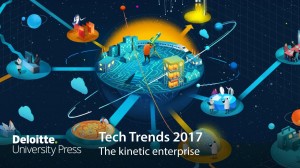Bristol firms have been given a unique glimpse of the top tech themes for this year – and the impact they are likely to have on business – at a special event staged by accountancy firm Deloitte.
Ever-greater use of smartphones, digital navigation, machine learning and – on the downside – the growth in cyber crime were outlined by Deloitte’s technology, media and telecommunications (TMT) practice. 
The firm’s head of TMT Paul Lee led the briefing staged at the Engine Shed, Bristol, and discussed key trends for this year as highlighted in the 16th edition of the firm’s widely-respected TMT Predictions 2017 launched in January.
He said the predictions particularly resonated with Bristol’s digital tech ecosystem as it continued to be among the UK’s most innovative and fastest-growing.
Deloitte’s key technology predictions for 2017 are:
Digital navigation: no more getting lost indoors
Deloitte predicts that one in 20 uses of digital navigation in 2017 will be indoors. By 2022, at least a quarter of all human and machine uses of precision digital navigation will include an indoor leg or be for an entirely indoor journey. With every year, getting lost indoors will get increasingly harder.
The growth of indoor navigation will be boosted by the growing availability of an array of indoor positioning data and improvements in the accuracy of data generated by beacons, wi-fi hotspots and cellular base stations. Advanced analytical tools will be required to interpret multiple location datasets in parallel in order to produce high-quality location.
Precise indoor navigation’s potential is significant, and could be transformative. It is likely to benefit most vertical sectors, impacting government, business and consumers alike. Indoor navigation is also likely to be used for people and things, to locate rapidly items of value in a range of locations, from tools in a workshop, goods in a warehouse, parts on a factory floor, to suitcases in the hold of a plane.
Deloitte lead partner for technology, media and telecommunications in the South West Laurence Hedditch, pictured right, said: “We are all  aware of the impact that satellite-based digital navigation, including the digitisation of street maps, has had on our daily way of living, and on business models.
aware of the impact that satellite-based digital navigation, including the digitisation of street maps, has had on our daily way of living, and on business models.
“However, satellite navigation has one fundamental blind spot – its signals are often too weak to penetrate building roofs. Yet people spend over 90% of their time indoors. Billions of objects, from vehicles to tools to components, all of which may need to be located, are housed somewhere under a roof.
“Being able to locate people and objects when indoors is likely to add significant value, possibly at a level equivalent to or greater than the impact that outdoor digital navigation has had.”
Brains at the edge: machine learning goes mobile
Deloitte predicts that more than a fifth of smartphones sold in 2017 (more than 300m units) will have machine learning capabilities within the device in the next 12 months. Mobile devices will be able to perform machine learning tasks even without connectivity which will significantly alter how humans interact with technology across every industry, market and society
Machine learning essentially means that our phones will be designed to mimic aspects of the human brain’s structure and function. This functionality will enhance applications including indoor navigation, image classification, augmented reality, speech recognition and language translation – even where there is little or no cellular or wi-fi connectivity.
Recognising, for example, that an object is a face – and whose face it is – in a world of varying light sources, hats and glasses, is remarkably challenging for programmers. It’s a challenge that’s better dealt with by machine learning – the process by which computers get better at performing tasks through exposure to data, rather than through explicit programming.
Although some smartphones in 2016 were capable of extremely limited machine-learning tasks such as recognising a fingerprint, more powerful cognitive tasks only worked when connected to large data centres far away.
Laurence Hedditch added: “Software and hardware developments mean that neural networks can now be provided at prices, sizes and power consumption that are compatible with smartphones.”
However, over time machine learning on-the-go will not just be limited to smartphones. These capabilities are likely to be found in tens of millions (or more) of drones, tablets, cars, virtual or augmented reality devices, medical tools, Internet of Things (IoT) devices and unforeseen new technologies.
“Machine learning is fascinating as it will revolutionise how we conduct simple tasks like translating content, but it also has major security and health consequences that can improve societies around the world,” said Laurence Hedditch.
“For example, mobile machine learning is a strong entry point to improve responses to disaster relief, help save lives with autonomous vehicles, and even turn the tide against the growing wave of cyberattacks.”
Prints charming: biometric security reaches the billions
According to Deloitte, the active base of fingerprint reader-equipped devices will top one billion for the first time in early 2017. Each sensor will be used, on average, 30 times a day, resulting in more than 10 trillion aggregate uses globally.
Our research suggests that approximately 40% of all smartphones in developed countries will incorporate a fingerprint reader by the end of the year, up from 30% as of mid-2016. At least 80% of users with a fingerprint reader-equipped smartphone will use this sensor regularly; this compares to 69% of users in mid-2016.
 Paul Lee, pictured left, said: “Billions of smartphones and tablets are expected to be capable of processing and collecting multiple types of biometric inputs, including face recognition, voice pattern and iris scan in 2017, but usage of fingerprints will lead the way. The rapid pace of adoption of this technology will likely be met with additional applications that could use fingerprint readers to provide fast and secure authentication.
Paul Lee, pictured left, said: “Billions of smartphones and tablets are expected to be capable of processing and collecting multiple types of biometric inputs, including face recognition, voice pattern and iris scan in 2017, but usage of fingerprints will lead the way. The rapid pace of adoption of this technology will likely be met with additional applications that could use fingerprint readers to provide fast and secure authentication.
“The fingerprint has proven to be the most popular form of biometric security on smartphones and the concept of fingerprint security is increasingly becoming normalised. This is important: as fingerprint security becomes more common, consumers will find it easier – and will be more willing to pay for goods and services using their smartphones.”
Cyber attacks enter the terabit era
Deloitte also predicts that in 2017 Distributed Denial-of-Service (DDoS) attacks, a form of cyber attack, will become larger in scale, harder to mitigate, and more frequent. Deloitte expects there will be on average a terabit per second (Tbit/s) attack per month and over 10m attacks in total during the year. The average attack size will be between 1.25 and 1.5 gigabits per second (Gbit/s) of junk data being sent. An unmitigated Gbit/s attack (one whose impact was not contained), would be sufficient to take many organisations offline. 
Phill Everson, pictured right, the Bristol-based partner who also heads up cyber risk services at Deloitte in the UK, said: “This escalation in the DDoS threat is largely due to the growing number of vulnerable Internet of Things (IoT) devices and online availability of IoT-focused malware (both of which allow relatively unskilled attackers to hijack IoT devices and use them to launch attacks), as well as access to ever higher bandwidth speeds.
“Insecure IoT devices are vulnerable to being compromised and taken over by malign third parties. Such internet-connected devices range from video cameras, digital video recorders, routers to appliances in people’s homes that sometimes have hard-coded, unchangeable user IDs and passwords.
“Businesses of all sizes should acknowledge the growing DDoS threat and consider how best to handle attacks of these magnitudes.”






























